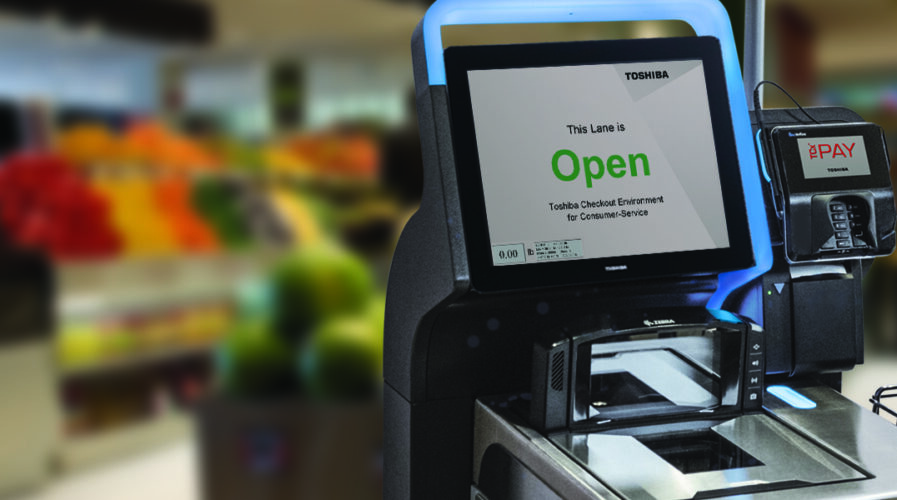
“When you talk about “frictionless”, you want to make the checkout as seamless as possible.” – Toshiba. Source: TGCS
Toshiba is making self checkouts contactless with computer vision
- With the pivot towards e-commerce & more contactless purchasing solutions, POS market leader Toshiba tells us about transformation in the Southeast Asian retail sector
Retailers and consumers on both sides of the aisle are looking towards contactless, cash-free methods for purchasing and making payments, instead of using cash or touch-payment terminals.
In fact, a Mastercard study found that two thirds (68%) of shoppers in the Asia Pacific (APAC) region say they want to use contactless payment methods alone to make their purchases.
Pursuing such frictionless payment solutions is precisely what Toshiba Global Commerce Solutions (TGCS), a global market leader in point-of-sale (POS) systems, is aiming for. With clients representing 60% of the top 25 global retailers, TGCS’ sales director growth markets Vikrant Bhalla spoke to Tech Wire Asia about where this retail transformation journey is headed for retailers in APAC.
Since Toshiba acquired IBM’s retail business in 2012, TGCS was formed to focus wholly on commerce systems: “We sell solutions. Not just hardware, not just software, we sell end-to-end solutions for retailers,” states Sales Director Bhalla. “They want their business problems solved by people who understand about retail, and that’s where we add value because our company DNA is all about retail. We’ve got 2000+ people who are focused on retail, and retail alone.”
With COVID-19 lockdowns still in partial effect in many of the emerging markets that he is involved in, Bhalla and TGCS noticed the shift in what consumers are demanding from retailers during this time. “It’s pretty much all around omnichannel, contactless… how do we open up our existing infrastructure or the environment that we have to be enabling our systems in, so we can address the market that is in front of us,” he explains.
As a solutions specialist, do newer technologies like computer vision and artificial intelligence (AI) help provide a more friction-free customer journey?
According to Bhalla, “in our roadmaps we have the computer vision as well as the AI to be integrated into the self-checkout for things like product recognition. So when you talk about ‘frictionless’, you want to make the checkout as seamless as possible.”

The focus in retail now is “all about omnichannel, contactless”, says Toshiba. Source: TGCS
New self-checkout systems using AI-driven computer vision capabilities can help with fresh produce management in stores, and enable loss prevention. “You don’t see self-checkout prevalence in Southeast Asia as yet compared to the more matured markets like Australia, New Zealand, or Japan, so what we are working on in that space is around ‘Hey, how can I recognize the products?
“If I scan an apple, [the system] would know it is an apple without needing a barcode. And not only an apple, what kind of apple it is. Is it crunchy, is it a Fuji apple, or whatever? And the database behind the system is constantly learning the behaviors as well as what people are scanning.
“The benefit of all this, of course, is a seamless, frictionless experience for the end-user– but it also helps the seller doing loss prevention. This part of the roadmap we actually demonstrated this year at the NRF this year, and I’d say in the next few months you will see these stuff being rolled out from our side.”
Cashless habits are sticking
Research by card provider Visa recently found that 66% of consumers in Singapore are forming cashless habits, with most (78%) saying they will stick with digital payment methods even after the pandemic’s effects are over. However, acceptance is less enthusiastic from Singapore’s neighbors in Southeast Asia.
“The first step in Southeast Asian countries has to be the acceptance of self-checkout. It is a very different retail environment country to country, we lump Southeast Asia together in ASEAN but there are differences in every single country.
“Singapore definitely, it is a prime market for the acceptance of self-checkout. And this [computer vision] solution can be integrated together with the existing contactless self-checkout systems in the country,” Bhalla continued. “You look at the Philippines; they don’t have any self-checkout in their stores– it is a very labor-oriented market because the cost of labor is low.
“But there is a huge level of interest already from there for this solution, because they see it more as an innovative solution that is coming into their market. They don’t just see it from an ROI benefit, they want to introduce such innovative tech so they can get customers coming back to their stores.”
READ MORE
- The criticality of endpoint management in cybersecurity and operations
- Ethical AI: The renewed importance of safeguarding data and customer privacy in Generative AI applications
- How Japan balances AI-driven opportunities with cybersecurity needs
- Deploying SASE: Benchmarking your approach
- Insurance everywhere all at once: the digital transformation of the APAC insurance industry


